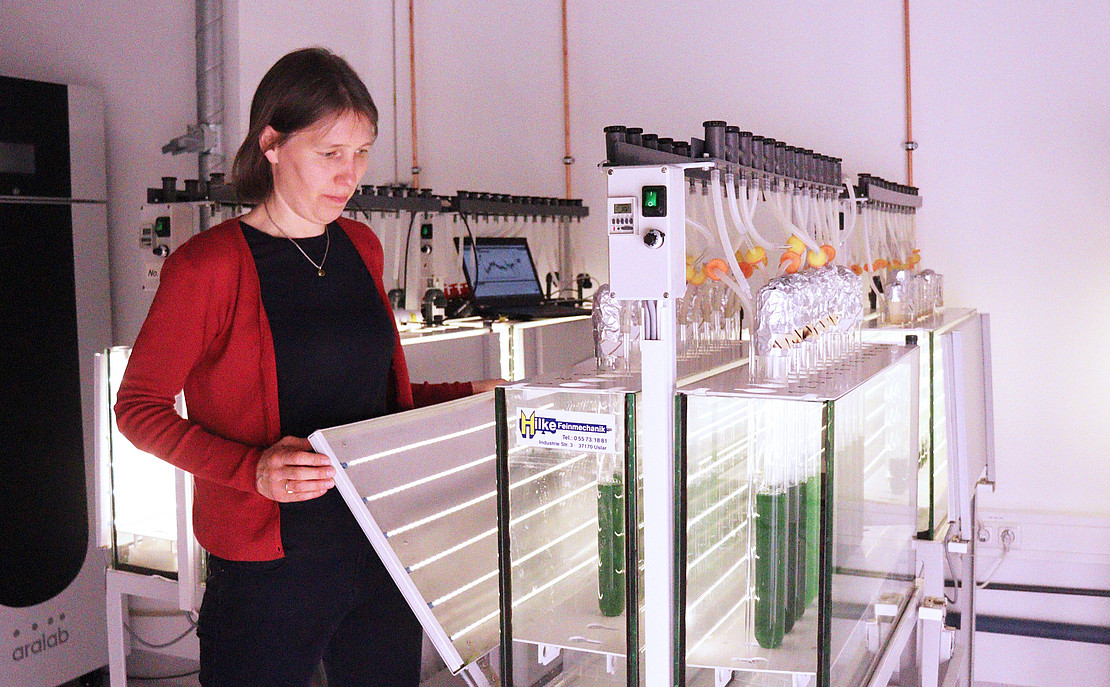This page contains automatically translated content.
Future in a glass
 Image: Sebastian Mense for Uni Kassel.
Image: Sebastian Mense for Uni Kassel.2.5 billion years ago, cyanobacteria did Earth a great service: they invented photosynthesis. The single-celled organisms filled the young planet's atmosphere with oxygen, created the ozone layer, kick-started evolution and - much later - made human life possible. "Now we have to ask them for another favor," says Kirstin Gutekunst.
This time, things are a little more urgent. Gutekunst, who has held a professorship in plant physiology since 2021, and her team are looking for ways to extract hydrogen from bacteria. There are great hopes for hydrogen: It can be used to store energy, transport it easily and release it in fuel cells - apart from pure water, there are no residues. It is, as the German government calls it, the "key element" for the energy transition, which is intended to protect the now overheated atmosphere from further damage. Numerous research projects are working on using renewable energies to produce hydrogen cheaply and without emissions, making it "green" and ready for the market.
The idea of Kirstin Gutekunst's team is even simpler: instead of photovoltaics or wind power, it relies on nature to produce hydrogen, on the photosynthesis of cyanobacteria, which has been tried and tested over billions of years. Just as farmers keep dairy cattle, so the idea goes, humans could one day cultivate cyano populations that produce the coveted gas for our fuel cells. But this requires outwitting the bacteria.
The farm in Kirstin Gutekunst's area of expertise is located on the third floor of the AVZ in Oberzwehren and bubbles quietly. Rows of large glass tubes are illuminated in special cabinets in a day-night rhythm and supplied with carbon dioxide. Inside, populations of various cyano strains glow in shades of blue and green - the bacteria used to be called "blue-green algae" until it was discovered that they do not have a real cell nucleus and therefore excrete as eukaryotes. Nevertheless, they do what plants do, they produce sugar and oxygen from carbon dioxide, water and solar energy - photosynthesis forms the basis for all life. "Everything we eat, everything we burn in the tank, all the air we breathe goes back to this," recalls Gutekunst.
Like plants, cyanobacteria also switch the process at night when they have no sunlight available and break down the sugar they produce. This releases electrons that have to be disposed of as waste. Incidentally, this is no different for us humans: we use these electrons to produce water, which we then exhale. Bacteria, on the other hand, dispose of some of these electrons at night in the form of hydrogen, so-called fermentative hydrogen. But hydrogen is also produced in a brief moment between darkness and incidence of light, so-called photosynthetic hydrogen. And it is produced as follows: When the bacteria "wake up", they immediately start photosynthesis. In doing so, they split water at their photosystems and release new electrons. However, the consumer for the electrons, the so-called Calvin-Benson cycle ofCO2 fixation, still needs a moment to start up. In this situation, electrons accumulate. The bacteria temporarily store these electrons by reducing H+ protons to H2 molecules - molecular hydrogen, which, so the idea goes, could be "tapped". The problem is that this phase takes less than a minute. Problem number two: the bacteria then break down this hydrogen themselves in order to use the stored energy. But Kirstin Gutekunst and her team have a plan.
The bacteria use a catalyst, known as hydrogenase, to produce the hydrogen. With a few manipulations to the hydrogenase, the professor has extended the "wake-up window" to several hours and thus multiplied hydrogen production. There are still undesirable side effects that inhibit or dilute the process. A lot of research is needed to perhaps one day make the process practicable and economical, studies with different catalyst mutations, bacterial strains and environmental conditions. If it succeeds, you can imagine the wonderful headlines the field would produce.
Scientists around the world are looking for ways to use photosynthesis, to recreate it, to produce and store hydrogen. "Fortunately, we're not the only ones," says Gutekunst. Even if the Oberzwehren Research Group is only making a small contribution to understanding the cyano-metabolism, it is a contribution to a major goal. Gutekunst is determined: "We simply have to try."
Sebastian Mense
This text is from publik 2/2022 from June 14, 2022